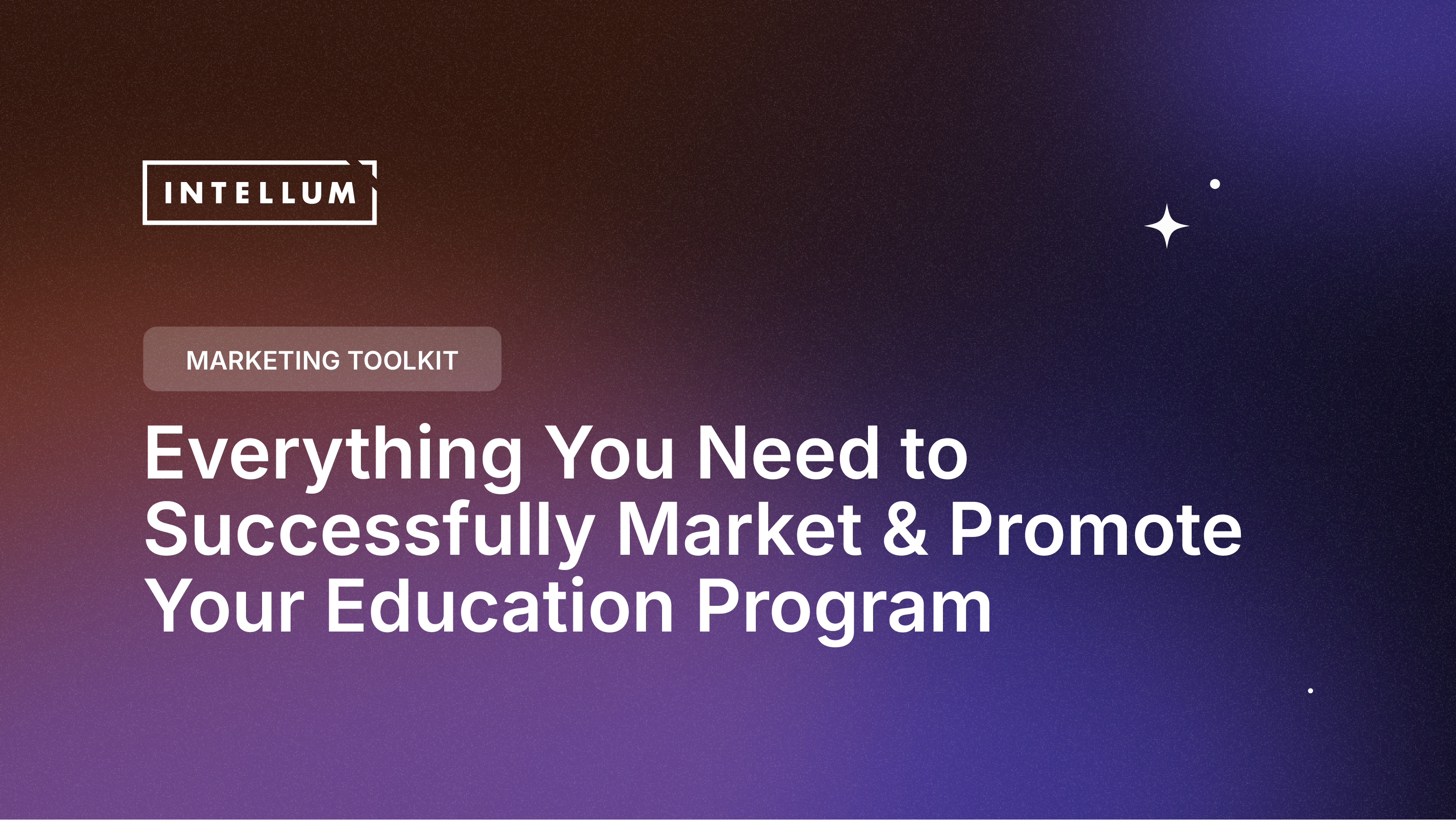To move customer education from ad-hoc activities and requests to a strategic function, we have to start with a solid strategy.
But what does it mean to create an effective customer education strategy? What goes into it and what does it look like?
And once you create it, how do you get buy-in from other teams to execute on this strategy?
Those are the questions we covered in our recent webinar with Greg Rose, CXO at Intellum, and Doug Pietrzak, a customer education subject matter expert formerly at Google and edX.
What is a Customer Education Strategy?
When you think of the word “strategy”, what comes to mind? The word conjures up a number of different connotations, depending on who you’re talking to.
Doug shared that to create a successful strategy, you first have to understand what “success” looks like to your primary audiences: executive leadership, customers, and supporting teams.
Your executive leadership team is going to be focused on overarching business objectives, like new revenue growth and reduced customer churn. Your customers might be interested in learning how to better use your product or service or grow in their career. And other teams might establish criteria like “increase customer satisfaction” and “decrease support tickets”.
To discover the success criteria for each audience, take time to sit down and talk with each relevant stakeholders. Ask what they want to see out of customer education and probe beyond the initial responses to drill down to what’s most important.
With this success criteria in mind, you can focus on the most meaningful and impactful objectives. Doug recommends targeting a limited number of business objectives in the beginning to make sure your work is focused and impactful.
How Do Business Outcomes Fit into an Education Strategy?
We’ve all heard that our customer education programs should be driving toward business outcomes, but how do you align learning program objectives with business objectives?
Doug shared that the key is to start by defining success in terms of business outcomes (e.g., new revenue growth, customer retention, etc.). Keep it focused to 2-3 business outcomes so you’re not stretched thin trying to prove value.
From there, work backwards to define learning objectives. Remember: Learning is about driving behavior change. So we want to focus on driving the right behaviors to move the needle on our business objectives.
Let’s say one of the business objectives is to increase customer retention. The question we need to ask is: What are the behaviors most likely to lead to customer retention? Let’s say product usage (whether frequency or depth of use) is one of those behaviors. We’ll want to design education that drives product usage—and have ways to measure that usage.
Keep in mind: If we can’t measure it, we can't prove the impact. We must start with clearly defined objectives and metrics that relate to those objectives.
Elements of an Effective Customer Education Strategy
For a customer education strategy to be successful, it has to be defined and documented. If it’s not clearly written down, it can’t be socialized, executed on, and referenced.
The best way to create your customer education strategy and get alignment on it is through a presentation deck. This should be short and simple—most of what we might consider necessary slides could actually go in the Appendix as reference material for people who are interested in digging deeper into the details.
Here’s what you’ll want to include in your strategy, according to Doug:
Overview of objectives, along with associated outcomes and measurements. We want to be clear about what we’re doing, why, and how we’ll measure the success of the initiative.
A quick note on partners and future opportunities. For your education programs to be successful, they can’t exist in a silo. They need to exist in partnership with other teams, like Product and Customer Success. It can also be helpful to foreshadow what’s coming in the future—to give people a vision for where education can go and what additional problems you can solve as the program matures. This keeps education from being a one-off initiative.
Here’s an example strategy slide Doug shared:

How to Socialize Your Strategy Across Teams to Get Buy-In
With your presentation deck in hands, it’s time to socialize your customer education strategy. Doug recommended spending at least 20% of your time socializing your plan, as this is a key aspect of making sure you have buy-in. A strategy that has not been properly socialized is a strategy that will not hold water over time.
This aspect of strategy development is an area many education program owners struggle with, because not every organization has clearly established ways of circulating and communicating work across teams. If this is the case in your organization, that’s OK! These tips will be helpful to you.
1. The presentation of your deck should not be the first point of socialization.
Doug shared that the ideal deck presentation is one where leadership is already bought in. How does that happen? By maintaining open lines of communication with key stakeholders. Gather success criteria, understand their goals and pain points, and regularly communicate how customer education can help. When you present your deck, it should be the codification of all these previous conversations.
2. Set a meeting or attend team meetings to share your plan.
On a very practical level, you need to set aside time to formally review your plan with key stakeholders. At Intellum, we call these “interlock meetings”, where teams get on the same page about work coming up.
If no meeting of this sort exists, put one on the calendar! You’re in charge of your program–don’t wait for someone else to put the meeting on the calendar for you.
3. Find your advocates.
It’s critical to have advocates throughout the company who believe in your education program. The 2023 State of Education Initiative Ownership Report found that education initiatives with a dedicated executive sponsor were more likely to achieve business goals. This may or may not be the executive over your customer education team.
In addition to your executive sponsor, identify and activate advocates on other teams who will champion customer education and partner with you on projects.
How Do You Use Your Customer Education Strategy to Secure Budget, Headcount, and Investment?
This is the biggest question we hear from customer education leaders. As Doug said during the webinar, “If we do the internal education right and measure well, these conversations become easier.”
If you’ve created and socialized a strategy that’s based on key stakeholders’ criteria for success, then executed against and that proved the impact of your work through the measures you set up, it’s easier to ask for budget and headcount.
Doug shared a hard truth during our time together, “Most teams are doing this backwards. They’re asking for budget and headcount, without first defining the business and learning outcomes, measuring against that, and showing the value.”
How Do You Push Back Against One-Off Customer Education Requests?
The bane of every customer education leader’s existence is random, one-off requests for education. “Can you create customer training for X?” “Can you build a course on Y?” How do you keep these types of requests from stealing your team’s attention from the work that matters most?
Doug recommended pulling back and asking a different question: Why am I getting these types of requests?
These types of requests might be indicative that a strategy with clear and measurable objectives either doesn’t exist or hasn’t been appropriately socialized. It’s easy to think, “But a strategy does exist. And I have shared it around.” Before assuming this isn’t the problem, ask a trusted colleague or your executive sponsor for their input. Are key stakeholders really clear on the current objectives and focus for your customer education program? If not, it’s time to take your customer education strategy back on a “world tour” to make sure all relevant teams are bought in and informed.
Another possibility is that your program is trying to boil the ocean. There are many benefits of customer education—but you can’t do everything at once. Consider if you’re trying to take on too much, leading your program to lose focus on the work that matters most.
Finally, it’s possible your team may not be holding the line. It’s hard to say “no” to projects that sound interesting, or that help build relationships with other teams. If your team keeps taking on new projects that don’t tie to your primary program objectives, you may be setting a precedent you don’t want to be setting.
Go Create Your Customer Education Strategy
A successful customer education strategy is within reach–and it’s the key to long-term retention and growth within your customer base.
A great strategy doesn’t start with educational content or interactive learning experiences. It starts with establishing success criteria and getting alignment across the organization on where and how customer education can make the biggest impact.
As you’re able to measure and prove the value of your learning programs, you’ll earn the right to more investment, budget, and headcount to grow your customer education program.





